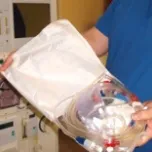A carbon footprint study of a UK renal service published in the Quarterly Journal of Medicinethis month confirms the importance of tackling supply chain emissions, revealing that the procurement of goods and services accounts for 72% of the carbon impact of kidney care - even more than the 60% from procurement in the NHS carbon footprint. Within procurement, the majority of emissions are attributable to pharmaceuticals, medical equipment and waste services.
Authored by Green Nephrology Fellow, Dr Andy Connor, and colleagues, this is the first carbon footprint study of an individual specialty service. The results again highlight the importance of tackling procurement practices to achieving sustainable healthcare: it is time that the NHS put in place real incentives and rewards for companies producing medical equipment and drugs at a lower environmental cost.
Dialogue with suppliers, taking place through the Green Nephrology programme, has shown that the industry is willing and keen to engage - but that where they do implement sustainable practices, these are not recognised in the procurement process. This is backed up by the results of the Green Nephrology Survey of Sustainability in Local Renal Units, which showed that fewer than 10% of renal services currently include sustainability clauses in procurement of renal products. Plans are afoot to change this, piloting a new set of sustainable procurement criteria in renal purchasing with three regional procurement hubs.
Another interesting finding is the contribution of waste services to kidney care's carbon impact - almost 10%. This is much higher than the 3% in the NHS carbon footprint as a whole, presumably because of the large consumption of plastic consumables in dialysis - most of which end up in the clinical waste stream and are therefore incinerated. Strategies to reduce unnecessary consumption, such as those identified by Mary Thomson (the Green Nephrology representative in Fife) will carry double benefits - reducing the environmental costs of manufacture as well as unnecessary waste disposal. And there remain many opportunities to improve segregation of non-contaminated waste to (lower impact) domestic waste streams and recycling.
Ultimately, however, the greatest carbon savings will come not from shaving off carbon from manufacture and waste disposal, but from clinical transformation. If the need for a test or treatment can be avoided, that will have the lowest carbon footprint of all...
Clinical services must be redesigned to be more preventative, to support greater empowerment of patients in managing their own care, and to eliminate wasteful activities - such as duplication of tests, or interventions without proven clinical benefit. Finally, we must better understand the carbon impact of the different treatments and technologies, such that these can be taken into account in redesign of clinical services. This paper is a crucial first step on that journey.

Please log in or sign up to comment.